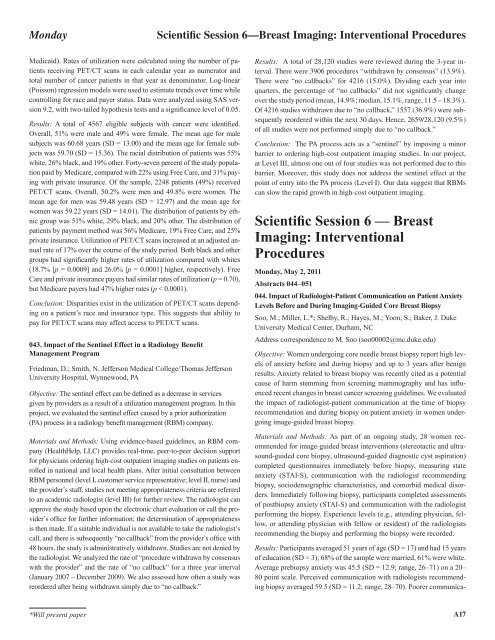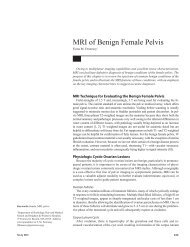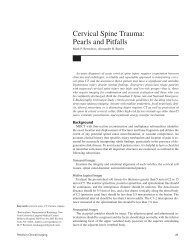Scientific Session 1 â Breast Imaging: Mammography
Scientific Session 1 â Breast Imaging: Mammography
Scientific Session 1 â Breast Imaging: Mammography
Create successful ePaper yourself
Turn your PDF publications into a flip-book with our unique Google optimized e-Paper software.
Monday<strong>Scientific</strong> <strong>Session</strong> 6—<strong>Breast</strong> <strong>Imaging</strong>: Interventional ProceduresMedicaid). Rates of utilization were calculated using the number of patientsreceiving PET/CT scans in each calendar year as numerator andtotal number of cancer patients in that year as denominator. Log-linear(Poisson) regression models were used to estimate trends over time whilecontrolling for race and payer status. Data were analyzed using SAS version9.2, with two-tailed hypothesis tests and a significance level of 0.05.Results: A total of 4567 eligible subjects with cancer were identified.Overall, 51% were male and 49% were female. The mean age for malesubjects was 60.68 years (SD = 13.00) and the mean age for female subjectswas 59.70 (SD = 15.36). The racial distribution of patients was 55%white, 26% black, and 19% other. Forty-seven percent of the study populationpaid by Medicare, compared with 22% using Free Care, and 31% payingwith private insurance. Of the sample, 2248 patients (49%) receivedPET/CT scans. Overall, 50.2% were men and 49.8% were women. Themean age for men was 59.48 years (SD = 12.97) and the mean age forwomen was 59.22 years (SD = 14.01). The distribution of patients by ethnicgroup was 51% white, 29% black, and 20% other. The distribution ofpatients by payment method was 56% Medicare, 19% Free Care, and 25%private insurance. Utilization of PET/CT scans increased at an adjusted annualrate of 17% over the course of the study period. Both black and othergroups had significantly higher rates of utilization compared with whites(18.7% [p = 0.0009] and 26.0% [p = 0.0001] higher, respectively). FreeCare and private insurance payers had similar rates of utilization (p = 0.70),but Medicare payers had 47% higher rates (p < 0.0001).Conclusion: Disparities exist in the utilization of PET/CT scans dependingon a patient’s race and insurance type. This suggests that ability topay for PET/CT scans may affect access to PET/CT scans.043. Impact of the Sentinel Effect in a Radiology BenefitManagement ProgramFriedman, D.; Smith, N. Jefferson Medical College/Thomas JeffersonUniversity Hospital, Wynnewood, PAObjective: The sentinel effect can be defined as a decrease in servicesgiven by providers as a result of a utilization management program. In thisproject, we evaluated the sentinel effect caused by a prior authorization(PA) process in a radiology benefit management (RBM) company.Materials and Methods: Using evidence-based guidelines, an RBM company(HealthHelp, LLC) provides real-time, peer-to-peer decision supportfor physicians ordering high-cost outpatient imaging studies on patients enrolledin national and local health plans. After initial consultation betweenRBM personnel (level I, customer service representative; level II, nurse) andthe provider’s staff, studies not meeting appropriateness criteria are referredto an academic radiologist (level III) for further review. The radiologist canapprove the study based upon the electronic chart evaluation or call the provider’soffice for further information; the determination of appropriatenessis then made. If a suitable individual is not available to take the radiologist’scall, and there is subsequently “no callback” from the provider’s office with48 hours, the study is administratively withdrawn. Studies are not denied bythe radiologist. We analyzed the rate of “procedure withdrawn by consensuswith the provider” and the rate of “no callback” for a three year interval(January 2007 – December 2009). We also assessed how often a study wasreordered after being withdrawn simply due to “no callback.”Results: A total of 28,120 studies were reviewed during the 3-year interval.There were 3906 procedures “withdrawn by consensus” (13.9%).There were “no callbacks” for 4216 (15.0%). Dividing each year intoquarters, the percentage of “no callbacks” did not significantly changeover the study period (mean, 14.9%; median, 15.1%, range, 11.5 – 18.3%).Of 4216 studies withdrawn due to “no callback,” 1557 (36.9%) were subsequentlyreordered within the next 30 days. Hence, 2659/28,120 (9.5%)of all studies were not performed simply due to “no callback.”Conclusion: The PA process acts as a “sentinel” by imposing a minorbarrier to ordering high-cost outpatient imaging studies. In our project,at Level III, almost one out of four studies was not performed due to thisbarrier. Moreover, this study does not address the sentinel effect at thepoint of entry into the PA process (Level I). Our data suggest that RBMscan slow the rapid growth in high-cost outpatient imaging.<strong>Scientific</strong> <strong>Session</strong> 6 — <strong>Breast</strong><strong>Imaging</strong>: InterventionalProceduresMonday, May 2, 2011Abstracts 044-051044. Impact of Radiologist-Patient Communication on Patient AnxietyLevels Before and During <strong>Imaging</strong>-Guided Core <strong>Breast</strong> BiopsySoo, M.; Miller, L.*; Shelby, R.; Hayes, M.; Yoon, S.; Baker, J. DukeUniversity Medical Center, Durham, NCAddress correspondence to M. Soo (soo00002@mc.duke.edu)Objective: Women undergoing core needle breast biopsy report high levelsof anxiety before and during biopsy and up to 3 years after benignresults. Anxiety related to breast biopsy was recently cited as a potentialcause of harm stemming from screening mammography and has influencedrecent changes in breast cancer screening guidelines. We evaluatedthe impact of radiologist-patient communication at the time of biopsyrecommendation and during biopsy on patient anxiety in women undergoingimage-guided breast biopsy.Materials and Methods: As part of an ongoing study, 28 women recommendedfor image-guided breast interventions (stereotactic and ultrasound-guidedcore biopsy, ultrasound-guided diagnostic cyst aspiration)completed questionnaires immediately before biopsy, measuring stateanxiety (STAI-S), communication with the radiologist recommendingbiopsy, sociodemographic characteristics, and comorbid medical disorders.Immediately following biopsy, participants completed assessmentsof postbiopsy anxiety (STAI-S) and communication with the radiologistperforming the biopsy. Experience levels (e.g., attending physician, fellow,or attending physician with fellow or resident) of the radiologistsrecommending the biopsy and performing the biopsy were recorded.Results: Participants averaged 51 years of age (SD = 17) and had 15 yearsof education (SD = 3); 68% of the sample were married, 61% were white.Average prebiopsy anxiety was 45.5 (SD = 12.9; range, 26–71) on a 20–80 point scale. Perceived communication with radiologists recommendingbiopsy averaged 59.5 (SD = 11.2; range, 28–70). Poorer communica-*Will present paperA17
















